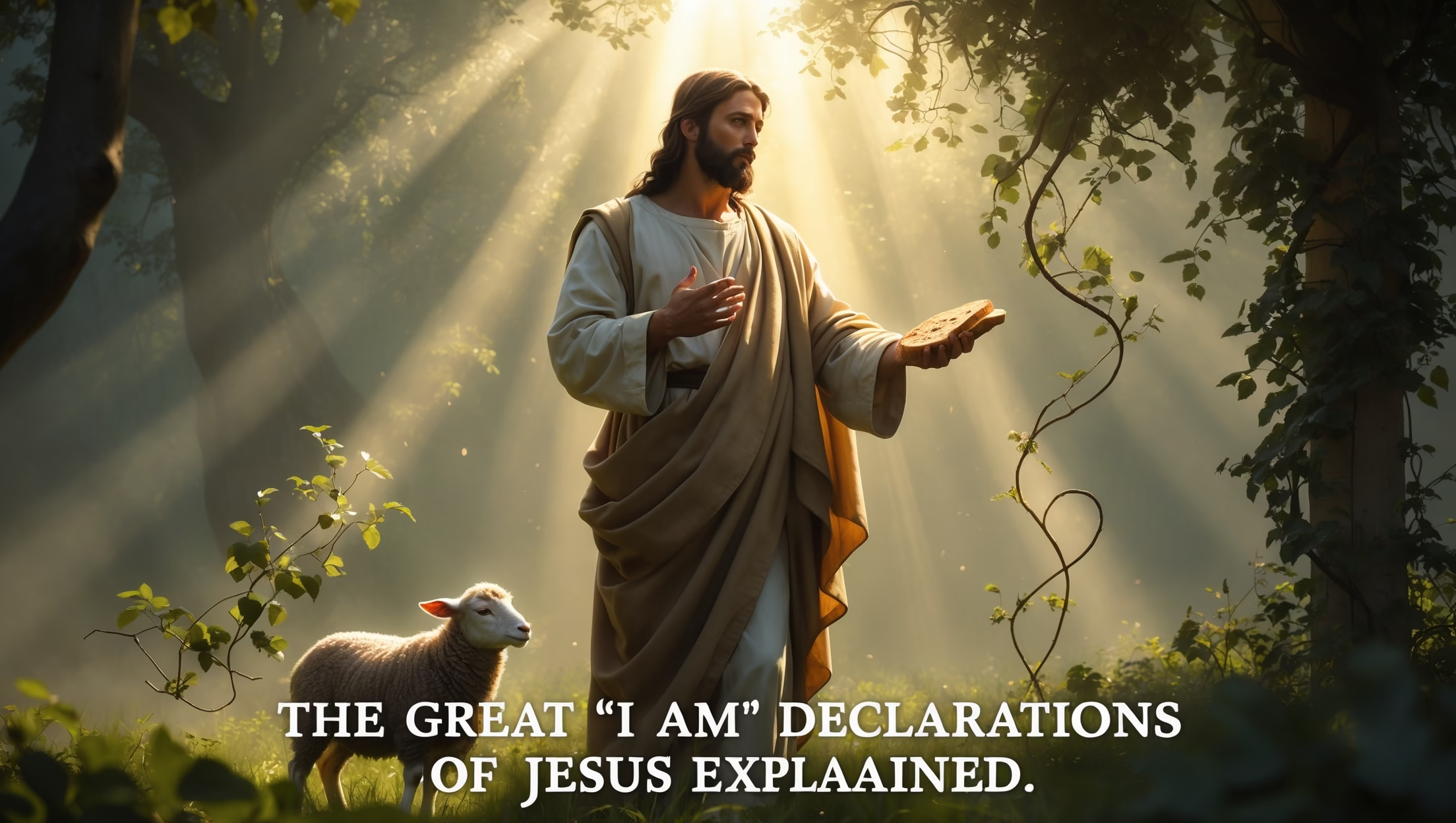Introduction
The Gospel of John uniquely preserves seven profound statements of Jesus beginning with the phrase “I am.” These declarations are deeply rooted in the Old Testament, where God revealed Himself to Moses at the burning bush, saying, “I AM WHO I AM” (Exodus 3:14). By using this phrase, Jesus identifies Himself not merely as a prophet or teacher, but as the divine presence in human form. Each “I Am” statement unveils a facet of His identity, mission, and the spiritual life He offers. Understanding these declarations helps believers see Jesus not only as the Messiah but also as the source of sustenance, guidance, and eternal life.

I Am the Bread of Life
In John 6:35, Jesus declared, “I am the bread of life. Whoever comes to me will never go hungry, and whoever believes in me will never be thirsty.” Bread, a staple of daily nourishment in the ancient world, symbolizes sustenance, and Jesus connects this basic physical need to the deeper spiritual hunger of the soul. Just as the Israelites relied on manna in the wilderness, spiritual life depends entirely on Him.
This statement emphasizes that satisfaction and life cannot be found in worldly things alone. Only through a relationship with Jesus—the Bread of Life—can humanity find lasting fulfillment. By offering Himself as the spiritual sustenance, Jesus fulfills both the physical typology of the Old Testament and the ultimate need of humanity: eternal life and connection with God.
I Am the Light of the World
In John 8:12, Jesus proclaims, “I am the light of the world. Whoever follows me will never walk in darkness but will have the light of life.” Light, throughout Scripture, represents truth, guidance, and hope. Darkness, by contrast, symbolizes ignorance, sin, and separation from God.
Jesus’ identity as the Light of the World emphasizes His role as the revealer of divine truth. His teachings illuminate moral and spiritual paths, offering clarity in a world often clouded by confusion and deception. Following Him is not merely intellectual acknowledgment but a surrender to the guiding presence of God in daily life. Light dispels darkness gradually, and Jesus promises to bring believers out of spiritual obscurity into understanding, purpose, and salvation.
I Am the Gate
In John 10:9, Jesus says, “I am the gate; whoever enters through me will be saved.” He presents Himself as the only legitimate entry into God’s kingdom, offering security, protection, and abundant life. The metaphor of a gate conveys exclusivity: while many paths claim to lead to God, only through Jesus can one find true salvation.
This statement highlights His role as protector and guide. Sheep are dependent on the shepherd to lead them safely, and through the “gate,” believers are sheltered from spiritual danger. Salvation is not just a future hope but a present reality for those who enter through Him, enjoying both security and provision in every aspect of life.
I Am the Good Shepherd
In John 10:11, Jesus identifies Himself as the Good Shepherd, one who lays down His life for the sheep. Unlike hired hands who abandon the flock at the first sign of danger, Jesus’ commitment is total. He guides, feeds, and protects His people, demonstrating sacrificial love and unwavering devotion.
This declaration reinforces the intimate relationship between Jesus and His followers. The shepherd imagery evokes trust, dependence, and care. By laying down His life, Jesus not only provides immediate protection but also secures eternal salvation, linking His pastoral care with His ultimate sacrifice on the cross. Believers are called to recognize His guidance, follow His direction, and rely on His protection in all circumstances.
I Am the Resurrection and the Life
When speaking to Martha in John 11:25, Jesus declares, “I am the resurrection and the life. The one who believes in me will live, even though they die.” This statement underscores His authority over life and death. It promises victory over mortality and the hope of eternal existence with God.
The resurrection of Lazarus provides a tangible demonstration of this power. Jesus not only comforts Martha with words but proves through action that He holds life in His hands. Belief in Him transforms the human perspective on death, offering assurance that physical death is not the ultimate end. His life-giving presence brings hope, restoration, and the promise of eternal communion with God.
I Am the Way, the Truth, and the Life
In John 14:6, Jesus identifies Himself as “the way and the truth and the life. No one comes to the Father except through me.” This declaration emphasizes exclusivity and completeness. He is the path to God, the embodiment of truth, and the source of eternal life.
The statement combines direction, knowledge, and vitality. Believers are invited to follow Him, trust in His revelation, and embrace the eternal life He provides. By claiming to be the only way to the Father, Jesus establishes the necessity of faith in Him as the foundation for salvation. Truth is not merely factual knowledge but a person—Jesus Himself—through whom reconciliation with God is made possible.
I Am the True Vine
In John 15:1, Jesus describes Himself as the true vine, with His followers as branches. Spiritual vitality, fruitfulness, and life come only through remaining connected to Him. Just as branches cannot survive apart from the vine, believers cannot thrive spiritually apart from Jesus.
This statement highlights dependence and intimacy. Remaining in Christ produces fruit such as love, joy, patience, and obedience, reflecting His character in the world. Disconnection from Him leads to spiritual barrenness, while abiding in Him ensures growth, resilience, and the fulfillment of God’s purposes. The vine metaphor also underscores the communal dimension of faith: believers are not isolated individuals but part of a living network rooted in the Messiah.
Conclusion
The “I Am” statements of Jesus reveal His multifaceted identity and mission. He is the Bread of Life, satisfying spiritual hunger; the Light of the World, bringing guidance and hope; the Gate, offering salvation and protection; the Good Shepherd, providing care and sacrifice; the Resurrection and the Life, defeating death; the Way, the Truth, and the Life, ensuring access to the Father; and the True Vine, sustaining spiritual vitality.
Through these declarations, Jesus reveals Himself as God’s presence in human form, a source of life, guidance, and salvation. Each statement invites believers into relationship, dependence, and trust, showing that He is not only teacher and prophet but the divine Son who offers light, life, and hope to the world. Understanding these profound truths challenges believers to follow, abide, and rely on Him in every aspect of life, knowing that the source of spiritual nourishment, protection, and eternal life is found in no one else but Jesus.








